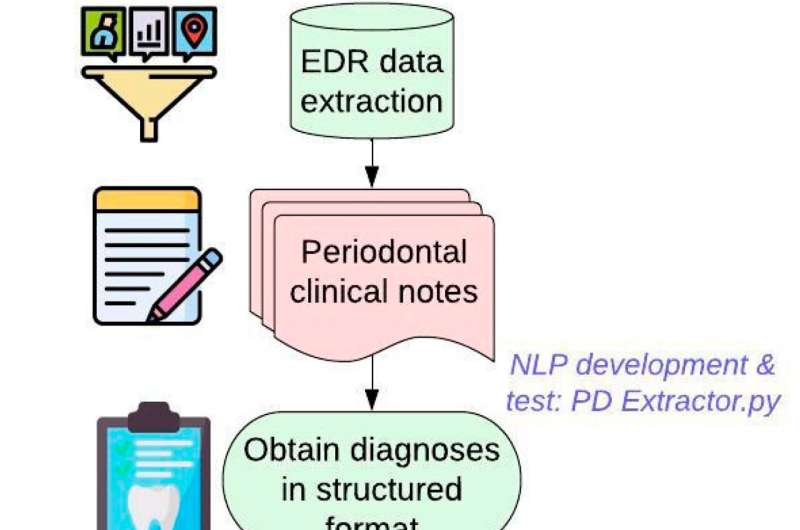
Development of automated computer algorithms to generate three groups of patients. Credit: Diagnostics (2023). DOI: 10.3390/diagnostics13061028
Periodontal disease is a growing public health issue in the United States as the nation’s population ages, yet it is underdiagnosed and undertreated. According to the US Centers for Disease Control and Prevention (CDC), 47% of adults age 30 and older and 79% of adults age 65 and older have some form of periodontal disease.
Researchers from the Regenstrief Institute and Indiana University School of Dentistry have developed computer algorithms to track the change in periodontal disease, which could help dentists and periodontists track disease progression. They have also developed tools that enable the use of electronic dental record data to automate disease diagnosis.
Their paper, titled “Development of Automated Computer Algorithms to Track Periodontal Disease Change from Longitudinal Electronic Dental Records,” is published in a special issue of the journal Diagnosticsentitled “Advances in biomedical and dental diagnosis using artificial intelligence”.
In the early stage of periodontal disease – gingivitis – the gums are swollen, red and may bleed. In its most severe form, called periodontitis, the gums may pull away from the tooth, bone may be lost, and teeth may loosen or even fall out. Maintaining natural teeth is important for good nutrition and other factors related to maintaining good health.
“Gum disease, which is often underdiagnosed, is reversible if diagnosed at an early stage before it affects the underlying structures and adversely affects tooth support. Allowing dentists to monitor the disease using both information in clinical notes and periodontal data mapping data contained in a patient’s electronic dental record can enable diagnosis and hope,” said Thankam Thyvalikakath, DMD, MDS, Ph.D., who leads the Regenstrief Institute-IU School of Dentistry Dental Informatics program.
He added that “we are here to develop and establish a culture of documenting and diagnosing cases in a structured way as is done in medicine,” noting that about 90% of dental practices in the US use electronic dental records.
“I think the advantage of our approaches is that by using routinely collected data, we can automate and monitor gingivitis treatments and changes that are only visible clinically, so we can catch gum disease at an early, potentially reversible, stage. This contrasts with other approaches that only use radiographs, which only show advanced gum disease.”
Factors that increase the risk of periodontal disease include tobacco use, diabetes, poor oral hygiene, stress, defective dental fillings and bridges, and medications that cause dry mouth.
“There is a two-way relationship between certain risk factors and gum disease,” said Dr. Thyvalikakath. “For example, diabetes increases the risk of periodontal disease, and periodontal disease negatively affects the course of diabetes. A similar relationship exists between cardiovascular disease and periodontal disease. Recognizing, monitoring, and treating gingivitis is an important part of overall health.” of the patient.”
More information:
Jay S. Patel et al, Development of Automated Computer Algorithms to Track Periodontal Disease Change from Longitudinal Electronic Dental Records, Diagnostics (2023). DOI: 10.3390/diagnostics13061028
Reference: Periodontal disease surveillance to improve diagnosis and treatment (2023, August 1) Retrieved December 16, 2023, from
This document is subject to copyright. Except for any fair dealing for purposes of private study or research, no part may be reproduced without written permission. Content is provided for informational purposes only.

